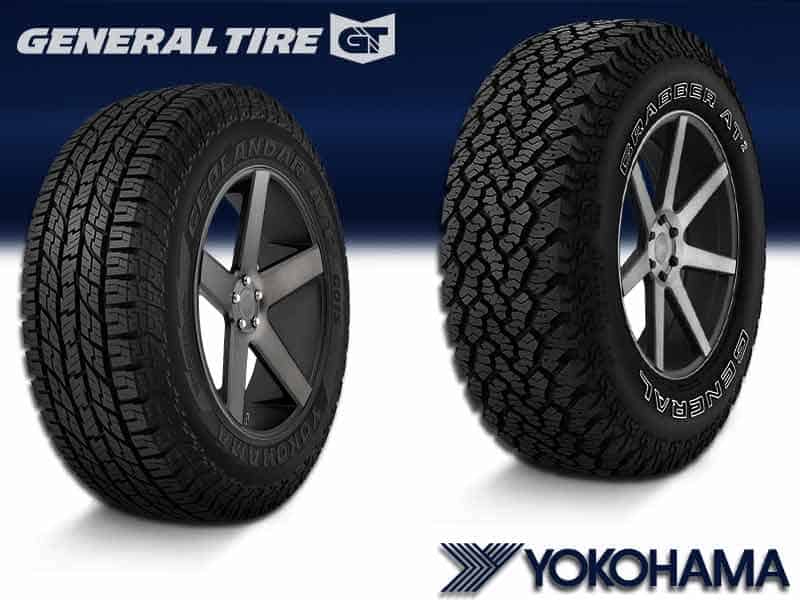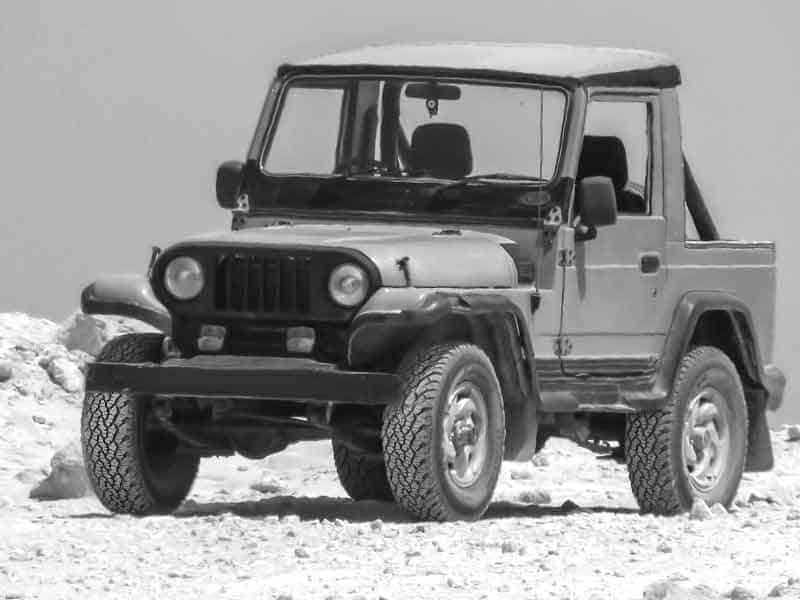Both are All-Terrain tires that offer excellent on and off-road traction. However, the on-road traction of Geolandar is better because of its narrower grooves which increase its contact with the road.
On the other hand, General Grabber is superior when it comes to rocky terrains due to its wider grooves and bold stone ejectors.

Want to know which tire performs better in terms of off-road traction? Let’s find it out in this comprehensive article!
Table of Contents
Comparing General AT3 with Yokohama G015
Yokohama G015 AT

General Grabber AT3


Vs

Yokohama Geolandar consists of a five-pitch tread design that has two outward shoulders and three block columns.
While the outward tread block columns measure the same, the inward measures a bit differently than the other two.
The entire tread is divided by narrow circumferential grooves that separate the shoulders and the central blocks. In addition to this, the shoulders of this tire are quite compact which enhances its grip on dry roads.

The General Grabber AT3 features wider grooves that separate the shoulders and the central blocks found on its tread. The tire’s shoulder lugs are widely spaced in comparison.
As a result, its dry traction is reduced.
However, this is compensated by numerous sipes found all over the tread design. Furthermore, the presence of bold stone ejectors enhances the tire’s off-road traction even more.
On-Road Traction Comparison
Considering the on-road performance of Geolandar, this tire features narrower grooves and compact shoulders. As a result, its void ratio becomes lower leading to a higher contact patch with the road.
Therefore, its grip on the dry roads is maximized resulting in a shorter braking distance. However, the same performance is not translated into the wet traction of this tire.
That’s because even though the sipes on the tread are quite deep, they are not as numerous as its competitor. Therefore, the tire’s grip on wet roads is reduced resulting in a higher braking distance.

On the other hand, the void ratio of the General Grabber is higher due to its broad shoulders and wider grooves. For this reason, the grip of this tire on dry roads is not considered up to the mark.
However, when it comes to the tire’s performance on wet surfaces, it has numerous deep sipes on its shoulders and central part.
As a result, its grip is enhanced and the braking distance is lower. The hydroplaning resistance of the Grabber AT3 is also considered phenomenal due to its wider grooves and numerous sipes.
This combination allows a greater volume of water to pass through its tread and therefore, the tire can display impressive traction on flooded roads.
Off-Road Traction Comparison

Mud Terrain
Talking about the Geolandar’s performance on muddy terrains, it is not that impressive due to its narrower grooves.
That’s because these grooves can be easily stuffed with mud and as a result, the tire becomes more prone to slipping and losing its grip.
In addition to this, due to the compact shoulder design, there is a high chance that the mud particles also get trapped inside its shoulders. When all these factors are combined, the tire’s performance is compromised on mud.

In comparison, due to the wider grooves of General Grabber, its performance is exemplary on muddy terrains. It is fully capable of grabbing the mud in its grooves and thrashing it backwards. This performance is further aided by its open shoulder design.
For this reason, we consider this tire a better option to be taken on muddy terrains.
Snow Terrain
The performance of Geolandar is not considered that effective on soft snow terrains. That’s because it features narrower grooves which reduce its ability to thrash the soft snow backward and move forward.
Therefore, it loses its grip on soft snow.
However, the same is not the case on the icy terrains. The narrower grooves of the tire play a significant role in maximizing its grip on icy roads and that’s why, it is a good choice on icy roads.
General Grabber, on the other hand, features wider grooves in comparison. That’s why it is considered a better option in grabbing the snow in its grooves and throwing it backwards. However, when it comes to the tire’s performance on icy terrains, it is a bit weak.
The wider grooves reduce the contact patch of the tire and as a result, it becomes incapable of delivering fine traction on ice.
Rocky Terrain

When it comes to the Geolandar’s performance on rocky terrains, the absence of stone ejectors makes it weak on rocks. In addition to this, due to the narrower grooves, this tire is incapable of maintaining its tracks on uneven surfaces. As a result, its performance on rocky terrains becomes weaker.
On the other hand, due to the bold stone ejectors found on Grabber, it gets an edge over the Geolandar on rocky terrains. These stone ejectors stop the small stones and pebbles from getting stuck inside the tire’s grooves and its wider grooves are easily able to maintain grip on uneven surfaces. Therefore, its overall performance is considered far better on rocky terrains.
Comfort Comparison
The relatively narrower grooves of Geolandar will trap lesser air particles inside them and therefore, the back-and-forth movement of these air particles will also reduce.
This is what makes it a quieter option to drive on road. However, when it comes to the tire’s off-road comfort, the narrower grooves are not that efficient in absorbing the effects of bumps and jerks. Therefore, its off-road comfort is not considered up to the mark.
In comparison, due to the higher void ratio of General Grabber, its grooves can trap more air particles into them. When the trapped air rushes out of its grooves, it produces a loud noise and as a result, its on-road comfort is reduced.
But, the wider grooves of this tire play the role of shock absorber during off-roading. Therefore, it is considered a more comfortable option to drive on uneven surfaces.
Durability & Treadwear
The rolling resistance of the Geolandar is higher because of its higher contact patch and as a result, its tread will wear out faster than its competitor.
However, many built-in factors increase the durability of this tire. For example, its tread is constructed using all the high-quality materials such as carbon black and silica, this increases its overall tread life.
In contrast, the rolling resistance of General Grabber is lower due to its lower contact patch. Therefore, its tread will wear out slower than that of Geolandar’s. In addition to this, the carbon black compound used in its manufacturing adds more to its durability. Thus, it is considered a more durable option in comparison.
Price Comparison
Upon comparing the price, we found AT3 a higher-priced tire due to its incredible off-road traction. In addition to this, it is more durable as well.
However, if you are in search of something more affordable, the Yokohama Geolandar with its on-road dry traction and on-road comfort is something worth a shot too.
Quick Summary
- Both are All-Terrain tires.
- The on-road dry traction of the Geolandar is better.
- General Grabber performs better on mud, snow, and rocky terrains.
- The Geolandar’s performance on ice is more effective.
- On-road comfort of Geolandar is better and off-road comfort of General is superior.
- Grabber is a more durable option.
- Geolandar is a lower-priced tire.


